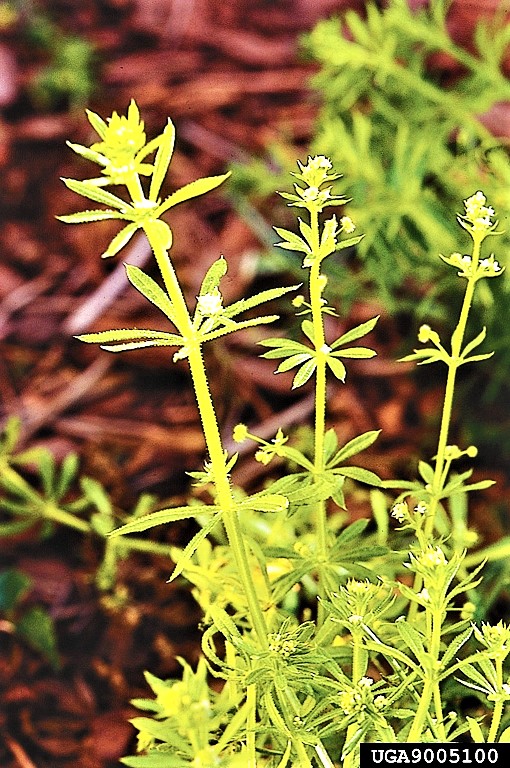It’s a sticky situation … all those spring weeds


Cleavers, or Velcro weed
I can’t tell you how many calls, emails, and texts I have received in the last few weeks asking about the “fields of gold,” whether in a farm field or in the backyard. Everyone wants to know what the beautiful daisy-like weed is. And just why haven’t we seen it before the last few years.
All political opinions related to the environment aside, weeds are on the move: Weeds that used to occur only in the southern part of Illinois are creeping up north. As our winters get milder and our soil temperatures warm sooner in the spring, plants and animals find our Northern Illinois climate more welcoming.
This yellow weed goes by many common names; Butterweed is the most common, but it is also called ragwort and crested groundsel. Botanically, Packera glabella, is a member of the aster (think flowers like daisies) family. This weed is actually native to Southern Illinois, then it started to creep up into central Illinois, and now it is here. And here to stay.
Butterweed is a winter annual or biennial weed that starts with a low rosette of leaves and then develops a central stalk that is 1 to 3 feet tall. Buttery yellow flowers (hence the name) emerge tightly around the stalk. As the flowers age, they spread out, and the entire flowerhead (infloresence) ends up about 6 inches across.
Butterweed likes a moist and cool habitat and disturbed soil. That is why it is seen so prevalently in agricultural fields in early spring. It is a benefit to some early pollinators and it even has its own specialized pollinator, the Andrenid bee. Less-common visitors are some of the early butterflies, including some skippers.
Butterweed does have a dark side though; If consumed, it is toxic to the mammalian liver because it contains pyrrolizidine alkaloids. Our deer avoid it, but sometimes livestock will poison themselves by consuming it. It can also cause fetal abortions in cattle, so it needs to be controlled in those situations. 2,4, D is effective as a chemical control, particularly during the rosette stage.
But many homeowners ask me if it is OK to just leave it because they like it. Of course! Always remember, a weed is only a weed as we define it. Weeds are usually plants out of place. If you talk to any gardener, one person’s weed is a prized plant to another.
Take our Illinois state flower for example, the blue violet. Some people love it, to others, it is the scourge of their perfect lawn. (To control violets in the lawn, use products containing trichlopyr. Always read and follow labelled instructions. As for me, I love the violet and transplant them out of my lawn to under many of my flowering shrubs. They form a thick mat that chokes out other weeds. I consider them a living mulch.
Besides the newly appearing butterweed, you may also find another yellow plant popping up in the garden. This one is more of a pastel yellow and the flowers are like gently arranged blobs. This plant is a member of the mustard family and is called yellow rocket. Botanically, Barbarea vulgaris arcuate, is a native to Eurasia. Since it flowers early, just like butterweed, it is a source of pollen for some small bees and occasionally butterflies. But unlike butterweed, yellow rocket is edible and is often grazed on by deer and livestock. I let this one pop up in my own garden, and it bridges the floral gap between bulb season and the early summer flowers.
The third most common weed question I am getting should have Lionel Ritchie’s “Stuck on you” as their byline. Cleavers or lady’s bedstraw Galium aparine) is another winter annual that seems to be everywhere the last five years. I see it deep in the forest, as well as a non-invited living mulch in my own yard.
This cling-on, often called Velcro weed, is a member of the Madder family (Rubiaceae) and has narrow leaves and stems, and an insignificant flower. Of all of the “stick-er” plants, this to me is the most well-behaved. Sure, it sticks to your shoes and clothes but is easily pulled off as the stickiness comes from stiff, downward facing hairs, not the loop/hook system of plants that have bur seed heads.
You can spend hours trying to comb out Fido’s hair, or in my case, my own hair. Usually, I go through every lubricating hair product trying to remove burs that got caught in my hair.
Cleavers occurs in every county in Illinois and is native to North America and Eurasia. Interestingly, long ago, cleavers were used to curdle milk in the production of cheese as the roots are somewhat acidic.
Cleavers is easy to remove by hand cultivation. They pull out easily even with the most shallow cultivation. Cleavers is also a great weed for kids to play with, as it is not sharp and they love sticking it to their clothes; then easily pulling it off again and sticking it somewhere else.